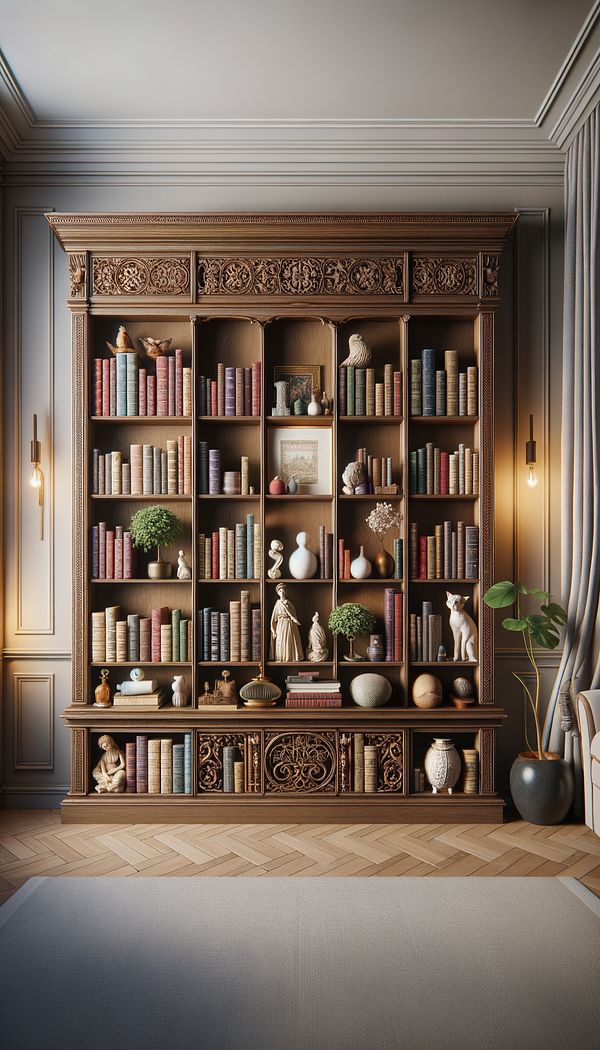What is a Bookcase?
A piece of furniture equipped with shelves, used for storing and displaying books.
Description
In the world of interior design, a bookcase is more than just a storage solution for books; it's a dynamic piece of furniture that can serve both functional and aesthetic purposes. A bookcase, essentially, is a furniture piece equipped with horizontal shelves designed primarily for the organization, storage, and display of books. From towering units that reach the ceiling to modest, low-rise models, bookcases come in various sizes, styles, and materials, making them versatile additions to practically any room.
The design of a bookcase can greatly influence the overall aesthetic and feel of a space. From traditional wood finishes to modern metal and glass combinations, the material and style of a bookcase can complement the design style of the room. Moreover, beyond holding books, these pieces often display decorative items such as photos, sculptures, and plants, which add personality and life to interiors. Innovative bookcase designs can also incorporate features such as built in lighting or integrate with other pieces of furniture for multifunctionality.
Choosing the right bookcase involves considering the available space, the volume of books and objects to be stored, and the decor of the room. Whether it’s a built in unit that blends seamlessly with the wall or a standout freestanding piece that draws attention, a thoughtfully selected bookcase can enhance the space both visually and practically.
Usage
Bookcases are commonly found in living rooms, home offices, libraries, and bedrooms, serving not only as storage for books but also as display areas for decorative objects. In professional settings such as offices and academic institutions, bookcases play a crucial role in organizing resources and materials. In interior design, bookcases are often selected or designed to match the aesthetic of the space, acting as focal points or complementary furniture pieces.
FAQs
-
Can bookcases be customized?
Yes, bookcases can be customized in size, style, material, and additional features like lighting or integrated seating to meet specific aesthetic and functional needs.
-
Are there eco-friendly bookcases?
Absolutely! Eco-friendly bookcases are available, made from sustainable materials such as bamboo, reclaimed wood, or responsibly sourced timber, and are manufactured in a way that has minimal environmental impact.
-
How can I decorate my bookcase?
Decorating a bookcase involves arranging books by size, color, or theme and incorporating decorative items like art, plants, and personal mementos. Utilizing baskets or boxes for organization and leaving some empty space can also add visual interest.
Practical Application
When selecting a bookcase, consider the size of the room and the height of the ceilings. Taller bookcases can make a room feel more spacious vertically, while shorter, wider bookcases might be better for smaller rooms. Evaluate the materials and finish to ensure it complements the room's design style. For an organized appearance, balance books with decorative items and use accessories to add color and texture.
-
Design Styles478 articles
-
Furniture Types599 articles
-
Decorative Objects240 articles
-
Storage & Organization79 articles
-
Three-Way SwitchA three-way switch is a type of light switch that allows you to control a light from two different locations.
-
Dado RailA dado rail is a horizontal strip of molding attached to a wall, typically around waist height.
-
Curved-Back SofaA curved-back sofa is a type of sofa with a rounded, continuous backrest.
-
Bunk BedA bunk bed is a type of bed in which one bed frame is stacked on top of another, allowing two or more beds to occupy the floor space usually required by just one.
-
Tea TableA small table designed for serving or enjoying tea.
